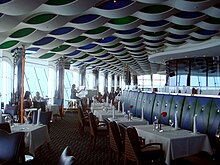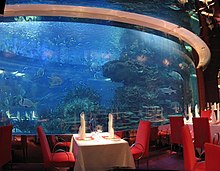Burj Al Arab
Burj Al Arab (Arabic: برج العرب,Tower of the Arabs) is a luxury hotel located in Dubai, United Arab Emirates. At 321 m (1,053 ft), it is the fourth tallest hotel in the world. Burj Al Arab stands on an artificial island 280 m (920 ft) out from Jumeirah beach, and is connected to the mainland by a private curving bridge. The shape of the structure is designed to mimic the sail of a ship. Sometimes described as "the world's only seven-Star hotel", its star rating has been often debated.
Site
The beachfront area where Burj Al Arab and Jumeirah Beach Hotel are located was previously called Chicago Beach. The hotel is located on an island of reclaimed land 280 meters offshore of the beach of the former Chicago Beach Hotel. The locale's name had its origins in the Chicago Bridge & Iron Company which at one time welded giant floating oil storage tankers on the site.
The old name persisted after the old Hotel was demolished in 1997. Dubai Chicago Beach Hotel remained as the Public Project Name for the construction phase of Burj Al Arab Hotel until Sheikh Mohammed bin Rashid Al Maktoum announced the new name.
Design and construction
Burj Al Arab was designed by architect Tom Wright of WS Atkins PLC. The design and construction were managed by Canadian engineer Rick Gregory also of WS Atkins. Construction of the Island began in 1994. It was built to resemble the sail of a dhow, a type of Arabian vessel. Two "wings" spread in a V to form a vast "mast", while the space between them is enclosed in a massive atrium. The architect Tom Wright[9] said "The client wanted a building that would become an iconic or symbolic statement for Dubai; this is very similar to Sydney with its Opera House, London with Big Ben, or Paris with the Eiffel Tower. It needed to be a building that would become synonymous with the name of the country."
The architect and engineering consultant for the project was Atkins. Fletcher Construction from New Zealand was the lead joint venture partner in the initial stages of pre-construction and construction. The hotel was built by South African construction contractor Murray & Roberts& Al Habtoor Engineering.
The building opened in December 1999.
Features
Several features of the hotel required complex engineering feats to achieve. The hotel rests on an artificial island constructed 280 m (920 ft) offshore. To secure a foundation, the builders drove 230 forty-meter (130 ft) long concrete piles into the sand.
Engineers created a surface layer of large rocks, which is circled with a concrete honeycomb pattern, which serves to protect the foundation from erosion. It took three years to reclaim the land from the sea, while it took fewer than three years to construct the building itself. The building contains over 70,000 m3 (92,000 cu yd) of concrete and 9,000 tons of steel.
Inside the building, the atrium is 180 m (590 ft) tall.
Burj Al Arab is the world's second tallest hotel (not including buildings with mixed use). The structure of the Rose Rayhaan, also in Dubai, is 11 m (36 ft) taller than Burj Al Arab.
Rooms and suites
The hotel is managed by the Jumeirah Group. Despite its size, Burj Al Arab holds only 28 double-story floors which accommodate 202 bedroom suites. The smallest suite occupies an area of 169 m2 (1,820 sq ft), the largest covers 780 m2 (8,400 sq ft).
Suites feature design details that juxtapose east and west. White columns show great influence. Bathrooms are accented by mosaic tile patterns.
Prices of rooms vary from approximately $1,000 to $27,000 per night.
Restaurants
Al Muntaha (Arabic for "Highest" or "Ultimate"), is located 200 m (660 ft) above the Persian Gulf, offering a view of Dubai. It is supported by a full cantilever that extends 27 m (89 ft) from either side of the mast, and is accessed to a panoramic elevator.
Al Mahara ("Oyster"), which is accessed via a simulated submarine voyage, features a large seawater aquarium, holding roughly 9,900,000 L (350,000 cu ft) of water. The tank, made of acrylic glass in order to withstand the water pressure, is about 18 cm (7.1 in) thick.
Rating
The hotel is officially rated Five-Star Deluxe. However, it is frequently described as "the world's only seven-Star hotel", although the hotel management claims to never have done that themselves. In the words of a Jumeirah Group spokesperson: "There's not a lot we can do to stop it. We're not encouraging the use of the term. We've never used it in our advertising." According to the group, the "Seven-Star" notion was brought to being by a British journalist who visited the hotel on a pre-opening press trip. The journalist "described Burj al Arab in her article as above and beyond anything she had ever seen and called it a seven-star hotel."
Reviews by architecture critics
Burj Al Arab has attracted criticism as well as praise, described as "a contradiction of sorts, considering how well-designed and impressive the construction ultimately proves to be." The contradiction here seems to be related to the hotel’s decor. "This extraordinary investment in state-of-the-art construction technology stretches the limits of the ambitious urban imagination in an exercise that is largely due to the power of excessive wealth." Another critic includes negative critiques for the city of Dubai as well: "both the hotel and the city, after all, are monuments to the triumph of money over practicality. Both elevate style over substance." Yet another: "Emulating the quality of palatial interiors, in an expression of wealth for the mainstream, a theater of opulence is created in Burj Al Arab … The result is a baroque effect".
See also
- W Barcelona (Hotel Vela) - skyscraper of similar appearance (sail)
- Vasco da Gama Tower - similar structure
References
- ^ "Burj Al Arab". Encyclopedia of Things. Glasssteelandstone. 3 January 2011. http://worldstallestskyscrapers.wordpress.com/2008/02/23/burj-al-arab-construction/. Retrieved 3 January 2011.
- ^ Burj Al Arab at Emporis
- ^ Burj Al Arab at SkyscraperPage
- ^ Burj Al Arab at Structurae
- ^ "Stay at Burj Al Arab". Jumeirah. http://www.jumeirah.com/en/Hotels-and-Resorts/Destinations/Dubai/Burj-Al-Arab/Suites/Staying-with-Us1/. Retrieved 4 January 2010.
- ^ a b Krane, Jim City of Gold: Dubai and the Dream of Capitalism, page 103, St. Martin's Press (September 15, 2009)
- ^ http://www.dubaiasitusedtobe.com/pages/galleries/chicagohotel.shtm
- ^ http://www.dubaiasitusedtobe.com/pages/places/chicagohotel.shtm
- ^ "Burj Al Arab". Galinsky. http://www.galinsky.com/buildings/burjalarab/index.htm. Retrieved 2008-06-08.
- ^ "Dubai's Dream Palace - Burj Al-Arab Hotel". Megastructures. No. 70.
- ^ "Dubai Chicago Beach Hotel - Fletcher Construction Company". http://www.fletcherconstruction.co.nz/project.php?project_id=105&archived=ye.
- ^ "Murray & Roberts". Murray & Roberts. 2006-06-21. http://www.murrob.com/. Retrieved 2007-01-24.
- ^ a b "Burj Al Arab". EgyptEng.com engineering directory. 2000. Archived from the original on 2007-01-17. http://web.archive.org/web/20070117194511/http://www.egypteng.com/projectm/burj.asp. Retrieved 2007-01-24.
- ^ Damluji, Salma Samar, The Architecture of the U.A.E.. Reading, UK: 2006.
- ^ a b "Hotel star ratings standards long overdue". The National. 2009-07-14. http://www.thenational.ae/business/travel-tourism/hotel-star-ratings-standards-long-overdue. Retrieved 10 December 2010.
- ^ a b c [The Architecture of the U.A.E..]
Further reading
- Rose, Steve. "Sand and Freedom", The Guardian, November 28, 2005, retrieved October 27, 2006.
- National Geographic Television. National Geographic: Megastructures, retrieved October 27, 2006.
External links
From Wikipedia, the free encyclopedia





No comments:
Post a Comment